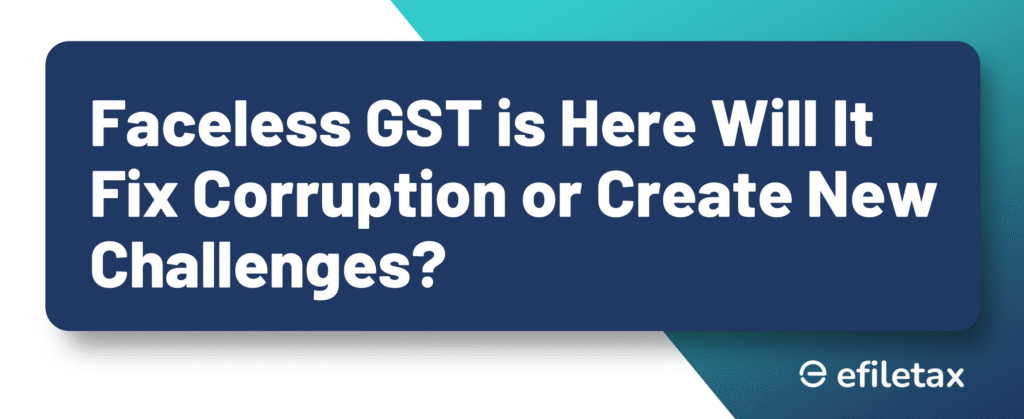
Summary
Faceless GST system is India’s bold push toward taxpayer-friendly governance. It eliminates personal interface, reduces corruption, and enables faster resolution. Here’s how it impacts compliance and boosts trust.
Introduction:
Faceless GST system is gaining momentum as India strives to modernize its indirect tax regime. With a vision to promote transparency, reduce harassment, and enhance ease of doing business, the government has started implementing faceless procedures in adjudication, scrutiny, and appeals under GST.
What Is a Faceless GST System?
Faceless GST refers to processes where taxpayer interactions with tax officials are digital, anonymous, and automated, with minimal to no human interface.
Key objectives:
- Curb corruption and subjectivity
- Standardize procedures across states
- Ensure faster resolution and fairness
- Promote taxpayer confidence
Legal and Policy Framework
The concept mirrors the Faceless Assessment Scheme introduced under the Income Tax Act. Similarly, under GST:
- Section 75(4) of CGST Act, 2017 requires a “reasonable opportunity of being heard” before issuing a demand.
- However, CBIC is encouraging faceless adjudication and scrutiny via circulars and back-end reforms in GSTN.
Key government steps:
- CBIC Circular No. 131/1/2020-GST emphasized data-driven compliance.
- 2023 and 2024 Union Budgets highlighted use of AI/ML for risk profiling.
- 2025 Vision Document of CBIC supports “faceless, paperless, and contactless” GST administration.
Benefits of a Faceless GST System
| Feature | Traditional GST | Faceless GST |
|---|---|---|
| Interface | Physical, manual | Digital, anonymous |
| Speed | Often delayed | Faster processing |
| Fairness | Officer-dependent | System-standardized |
| Corruption Risk | High | Significantly lower |
| Audit & Appeal | Local level | Centrally allocated |
Areas Where Faceless GST Is Being Implemented
1. GST Scrutiny Notices
- Notices auto-generated using AI-based anomaly detection (e.g., GSTR-3B vs GSTR-1 mismatch)
- Communication via GSTN portal only
- Replies must be uploaded in Form ASMT-11
2. Adjudication
- Allocation of cases randomly across states to reduce influence
- Virtual hearings with no need to visit GST offices physically
3. Appeals (Future Roadmap)
- GSTAT to implement online submission & hearings
- Certified copies & responses to be shared digitally
Expert View:
“Faceless GST will play a pivotal role in reducing litigation and fostering voluntary compliance. But success depends on robust tech infrastructure and taxpayer education.”
— CA Ramesh Joshi, GST Practitioner
Challenges in Implementation
- Digital divide among small taxpayers
- Need for capacity building in tax departments
- Clarity in Rule 142(1A) and other procedural overlaps
How Taxpayers Can Prepare
✅ Regularly reconcile returns (GSTR-1 vs GSTR-3B vs books)
✅ Maintain proper records for ITC claims
✅ Track notices on the GST portal
✅ Respond to queries within prescribed timelines
✅ Use digital tools or consult professionals for compliance
FAQs on Faceless GST System
Q1. Is faceless GST scrutiny active across India?
Yes, scrutiny through ASMT-10 is already being issued digitally across many states.
Q2. Can I meet the officer physically during faceless proceedings?
No. The system is designed to avoid physical meetings and ensure digital communication.
Q3. What if I miss a digital notice?
It can lead to adverse orders. Always check the GST portal notifications and email alerts regularly.
Conclusion
The faceless GST system is not just a tech upgrade — it is a cultural shift in tax administration. It brings transparency, reduces disputes, and builds a climate of trust. As India aims to become a $5 trillion economy, such reforms are essential to empower taxpayers and foster growth.
Need help navigating GST notices or faceless scrutiny?
Efiletax offers professional GST support, return filing, and representation services. Contact us today for a hassle-free compliance experience.